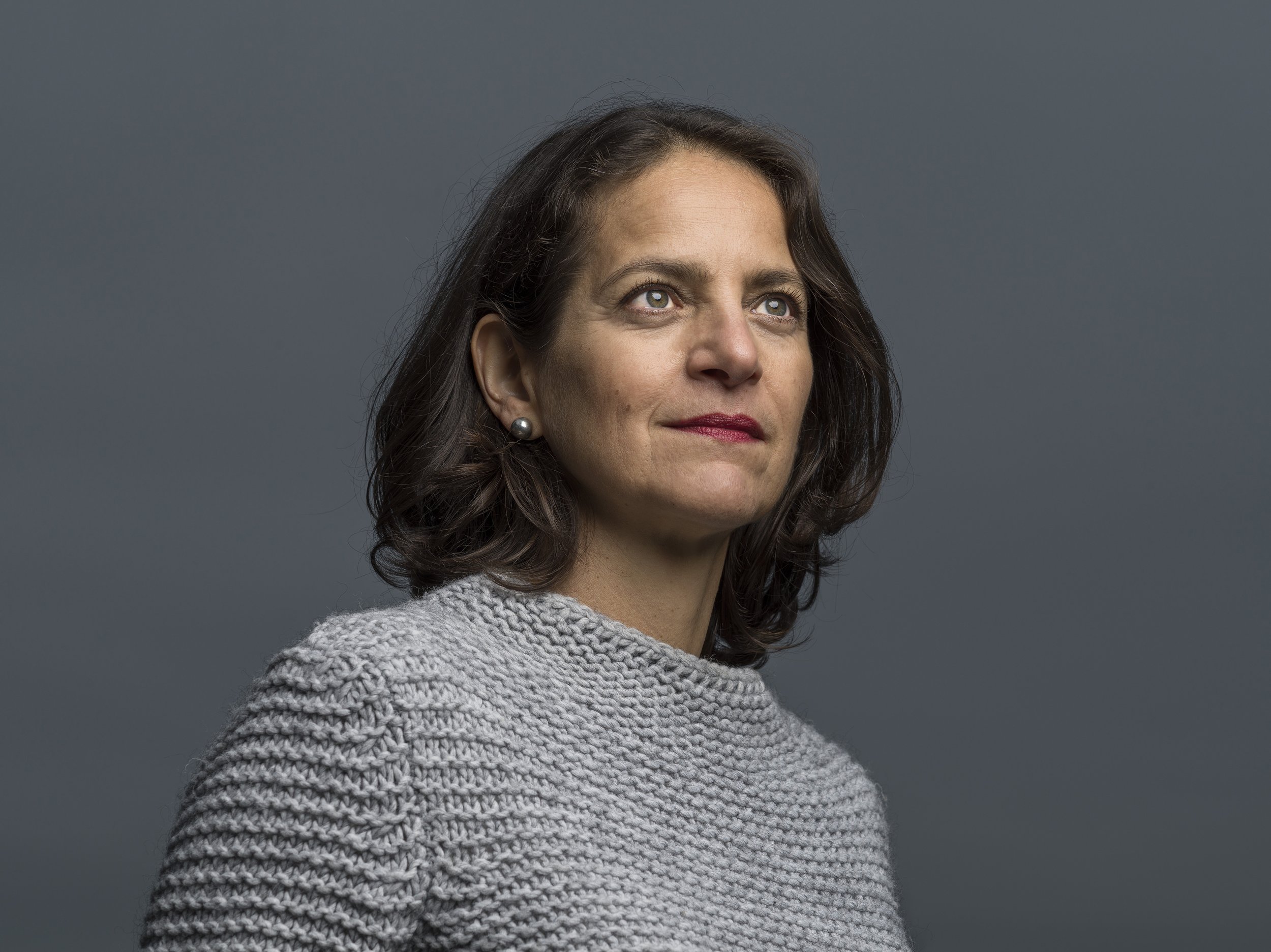A Particular Conversation with Dr. Gindi
Photo Credit: Braschler Fischer
Dr. Gindi is a sculptor whose main concern is with how it feels to exist as a human being, with what it means to generate purpose, and with how to enlighten the soul – in short, she strives to reveal the intricacies which characterize our psyche. In a sibylline manner, she refuses though to separate the conjectural probe of psychanalysis from daily life. Penetrating into the heart of the human condition, many of her sculptures are emblems of corporality ravaged by doubt, loneliness, and alienation.
Is there a common rationale that underlies her various works? Perhaps not, as many of Dr. Gindi’s positions are at loggerheads with each other. She can perhaps be best described as a field-defining synesthete, one who unconsciously varies traditions of inquiry and one who consciously frames new trajectories of inquiry. The unifying angle is that she endeavors to describe the infinite, the unutterable, the ineffable, which can never be absolute – succinctly, the sort of being and time that always remains.
Dr. Gindi is one of the most globally venerated sculptors. Her punctured and fragile three-dimensional art is often epically intense and has been displayed around the world. Originally educated as a medical doctor, she sculpts and lives in Switzerland.
I had the pleasure of speaking with Dr. Gindi about how psychological conjectures affect the human condition, what drew her to address the yearning for infinity, and by what means human beings can emerge out of oblivion.
UZOMAH: Dr. Gindi, you have consistently brought together the often-disparate fields of art and psychoanalysis. How can this approach address the yearning for infinity, the overarching theme in your work? And what role does the human psyche revel in your sculptures that are often bleak and merciless?
Dr. Gindi: What odd, despairing, and lonely creatures we are. Stripped of the fundamental need to belong, we stand denuded and stumble into the unbearable abyss of our self that gapes in front of us. Desperately searching for our purpose in life, it seems that we cannot escape the doom we dread the most.
I want to establish at the outset that there is a lot of angst and depression in the world and in all of us - especially in recent years, with mounting trauma and disconnection, as well as social, political, and environmental degradation. Trounced by the ruthless truculence of the human condition, my practice is often focusing on sorrow, grief, and other stratified anxieties, including the grim reality of death. Portrayed by geometries of disfigurement, I try to create morphs and melts of suffering that entails man’s secret and unconscious desires. Reflecting on the peripatetic state of shattered identity, I endeavor to reveal man’s vacuities and deficiencies and – as the psychoanalysts would say – his neuroses. Have a look at my sculpture Silent Resignation which tries to make throes visible. Void surrounds a character, the bog is beneath it, and the rift is within it. Just there, as the character is entombed in existence that climbs through its flesh—distended by aspiration, resigning from life in unmitigated solitude. The entire abraded corpus becomes a mesh, desexed and dashed. Murk lurks out of its skin.
We suffer from not comprehending as there are inner conflicts we cannot resolve, and bit by bit, we are flooded by fear, according to Sigmund Freud. The human shell becomes sick from the fear of fear. Neuroses bring bizarre derailments to the fore, thoughts that cannot be presided over, and phobias in which forms and objects attain different gist’s that make us frail and prone to decay. When brightness dims, dark prevails.
Freud concluded that human beings are hopeless misfits and eternal neurotics within the universe in which they are trapped. I disagree with Freud and some of his successors on this central point. Driven by radiant desire, I am certainly more auspicious. I define the human psyche as the totality of the personal experiences we have lived. But I would like to enlarge the texture of the human condition, giving it another spin and including in our observation the aspect of the soul, which is, for me, a vaster, much bigger undertaking. The psyche is, therefore, only an element within the all-embracing soul. I would even say that the soul interlaces the psyche like a gentle and transparent tissue. We are all thrown into a world with unbound choices, searching for deeper connection, longing for infinity – but it is purely the soul that understands.
Well -there are no human beings who do not have a bounty of delicacies to give. And to receive. Including the character in Silent Resignation. The gates to infinity are wide open to those who explore and probe, who straddle the abyss and embrace the essence of being. By creating and seeking - and despite possible agonizing rejection, estrangement, and loneliness - life can be lived as an infinite quest. Likewise, the characters in my sculptures are struggling and battling, but they are not broken in spirit. They strive to capture the infinite.

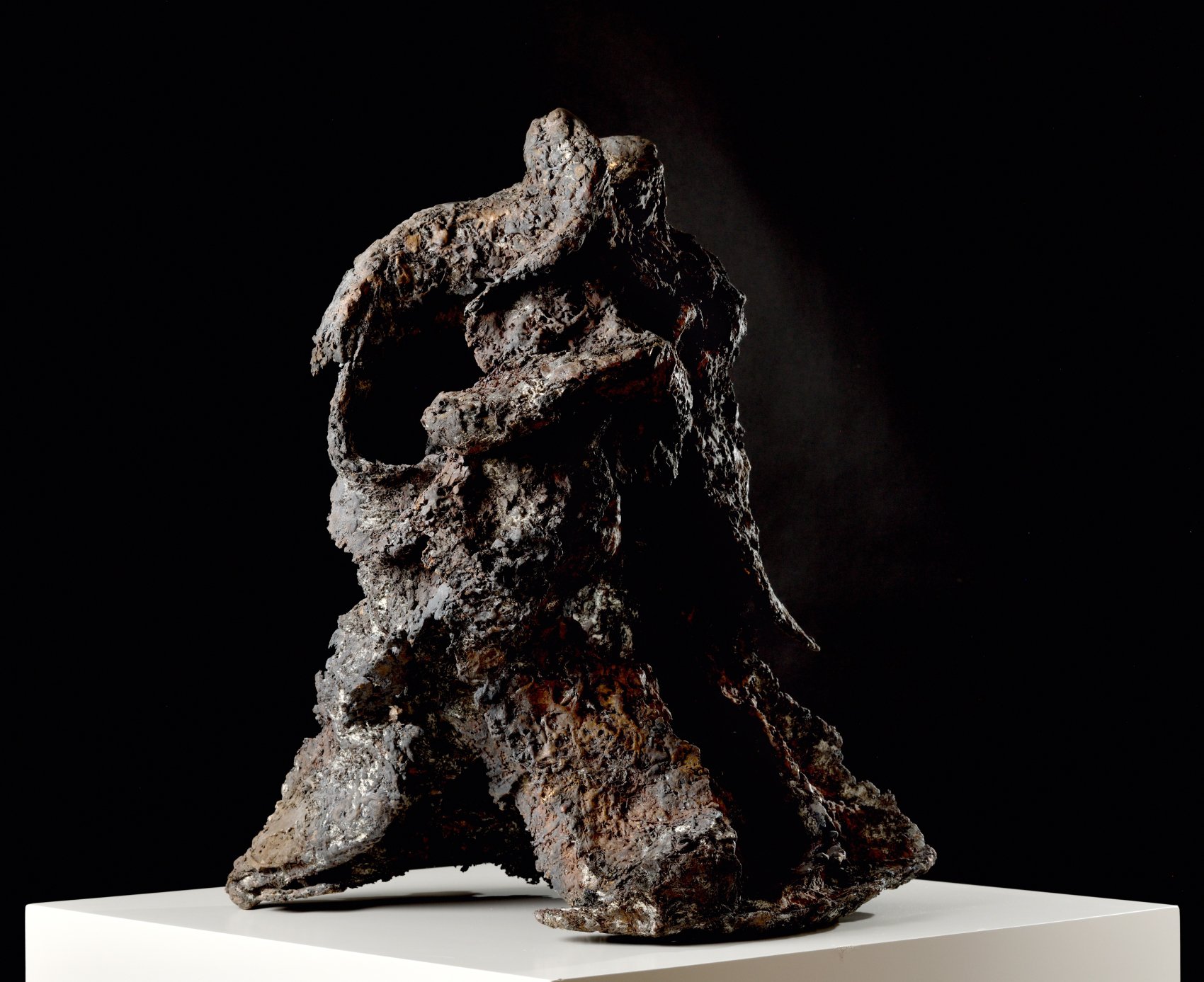
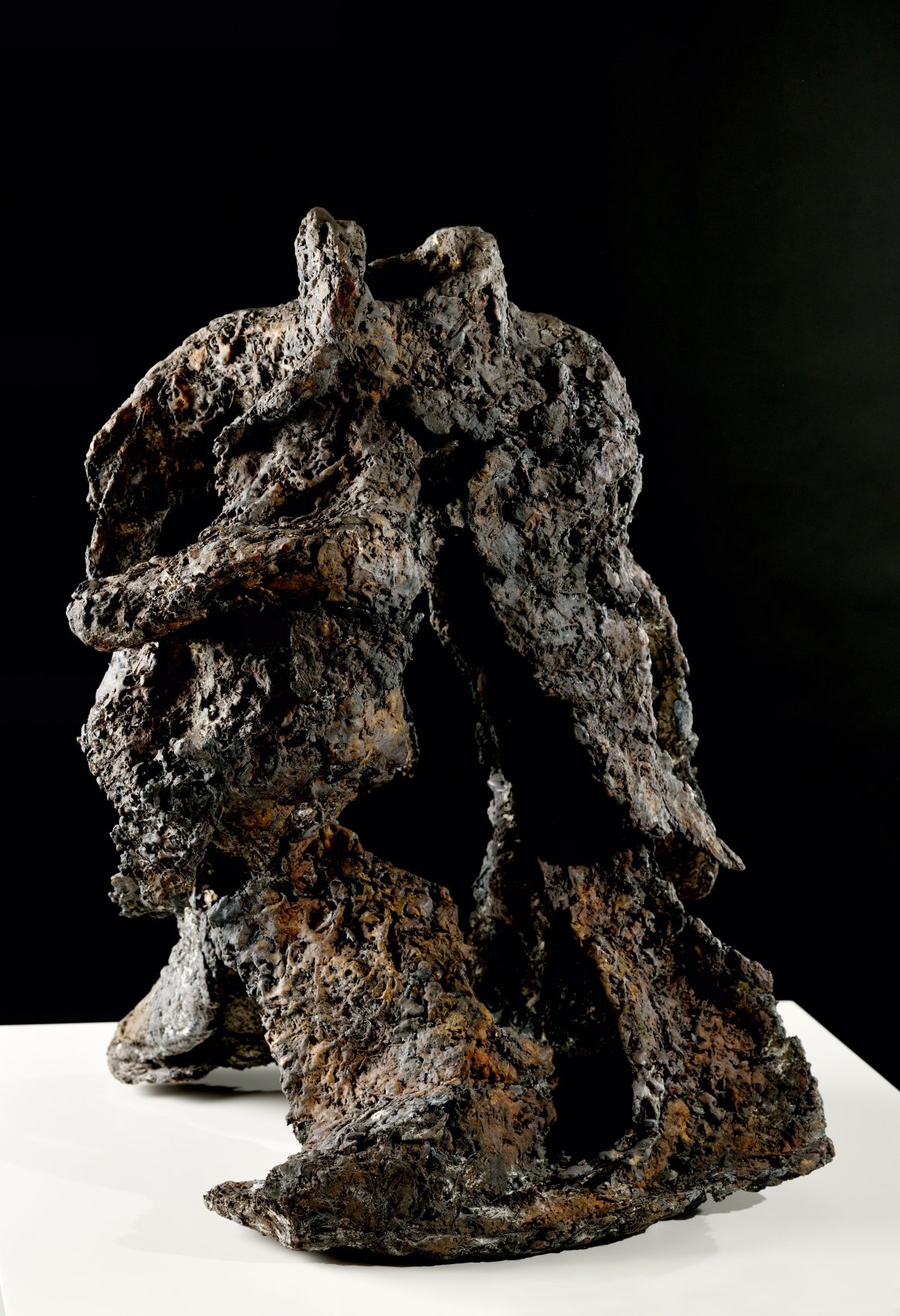

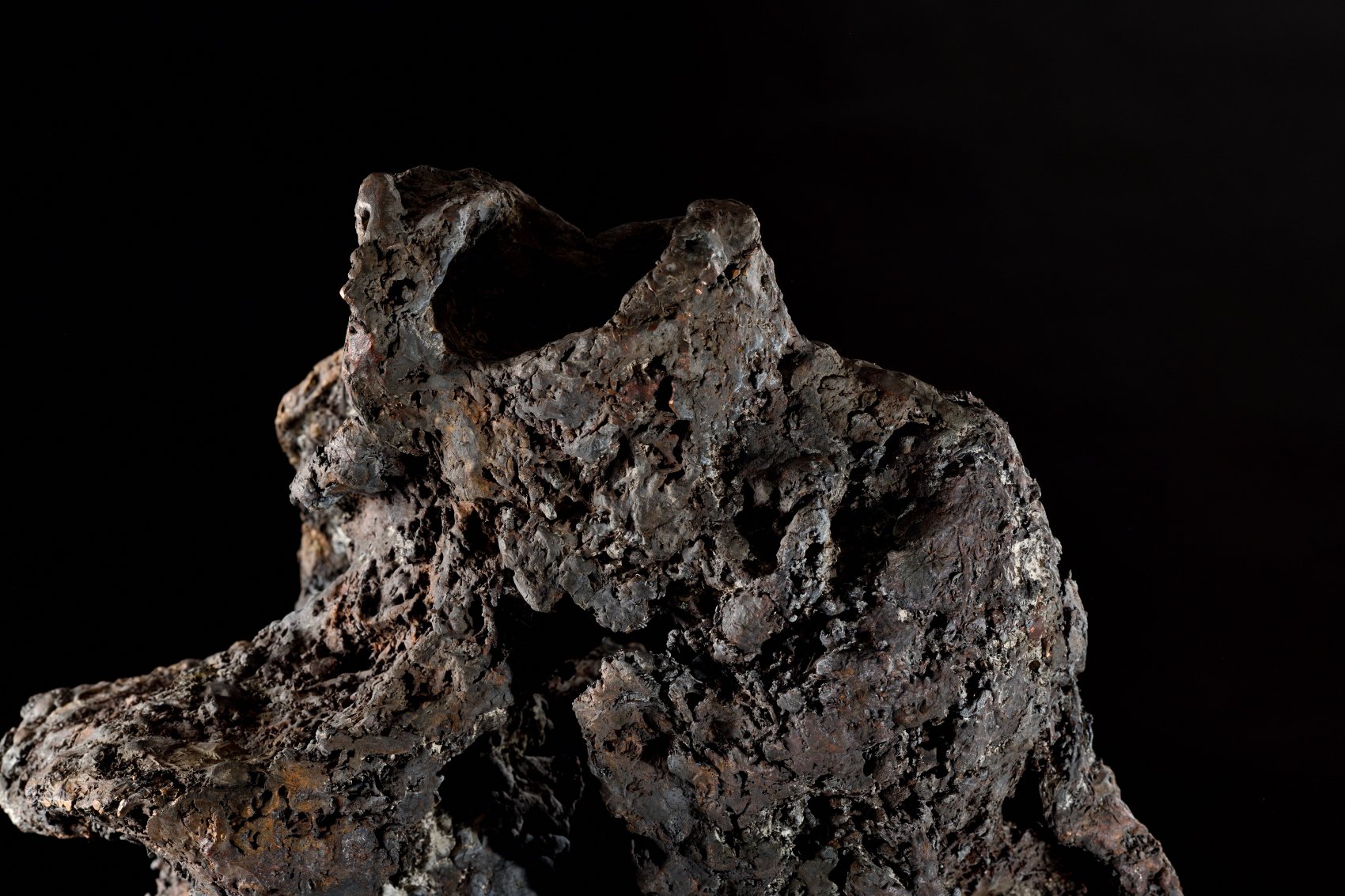
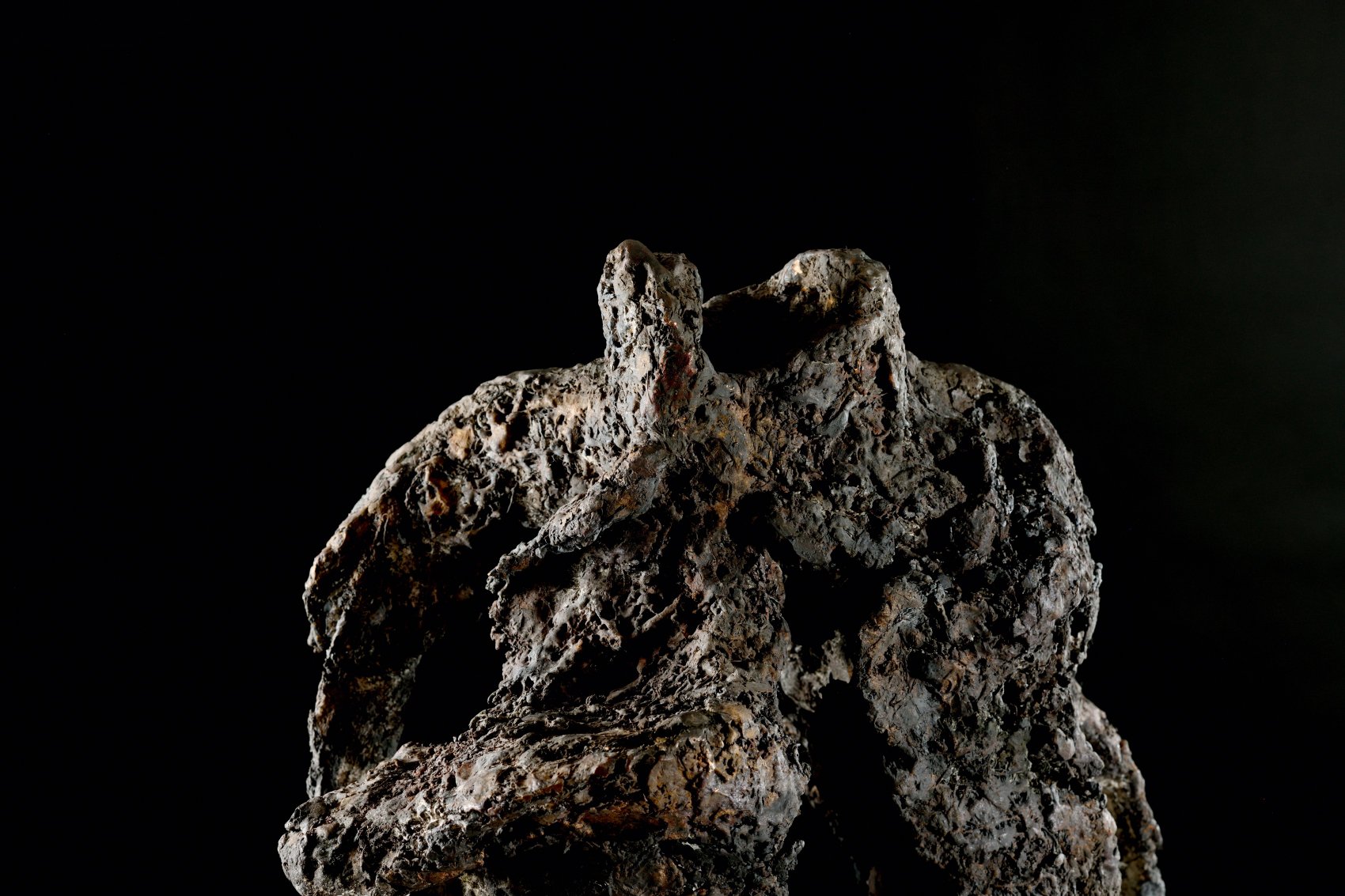
Self-Laceration Beyond Recognition Bronze, 57 x 44 x 43 cm
U: I do not want to interpret your work from a solely psychoanalytical point of view; translating Freud one-to-one, such an endeavor would trivialize your practice – and you just distanced yourself from Freud anyway. But if you would single out one pioneer of the understanding of the soul, who would you say has been the most formative sparring partner so far?
G: Let me give it a try, but, as a quick alert, I don’t want to build my own invisible prison as I am always pregnant with many sorts of furtherance. For Freud, to start with, the source of the unconsciousness is not the cerebrum but a libidinous zone of the body. He basically argued that the human search is reducible to sybaritic sexual needs. Drives that are derived from life instincts are the primary source of the unconscious. And we may get to know the unconscious by analyzing dreams.
I always felt that Freud limited the unconscious with his theories – we are not just driven by instincts and sexual phantasies. What drives us is the errand for development, for illumination, through all possible challenges and setbacks in life. Still, I don’t dispute the powerful role of the unconscious. We need to make the unconscious conscious.
I have to confess that I am a fan of French psychoanalyst and psychiatrist Jacques Lacan who proposed a theory that views the human condition as one of estrangement, linked to an experience of desire for the Infinite. In contrast to Freud, desire has little to do with sexuality; it is rather engrossed in social structure, in the figment version of reality that dominates human existence. The unconscious is structured through culture, which accrues though through anamnesis and memory or - in Lacanian terms - through language.
I hew to Lacan as he showed that desire drives us but also constricts us to interminable suffering. Our desire is conceived as endless; it can never be fully satisfied - that is the reason why we thrive and why we yearn. Whilst trying to grasp the infinite, we experience a permanent lack - because we only see ourselves in reflection, like in a rearview mirror – we never know how we really look like. Lacan, acutely influenced by existentialist reasoning, wielded an agnostic attitude toward the infinite. Aware of our own mortality, we pave the path between being and becoming with our unconscious desire.
Let me explain this position by referring to one of my most recent works, Self-Laceration Beyond Recognition. The sculpture illustrates a character who butchers itself, who swallows strain, and finally breaks his mental scraps, fleeing the self, flowing through its open wounds, admitting to the nous that life will never be self-sufficient. Yes, the central tenets of Lacanian psychoanalysis appear utterly hallowed to me, with both the weird and the wretched feelings they evoke. Lacan’s idea is that, at the most rudimentary level, the existential melts with the desire toward transcendence.
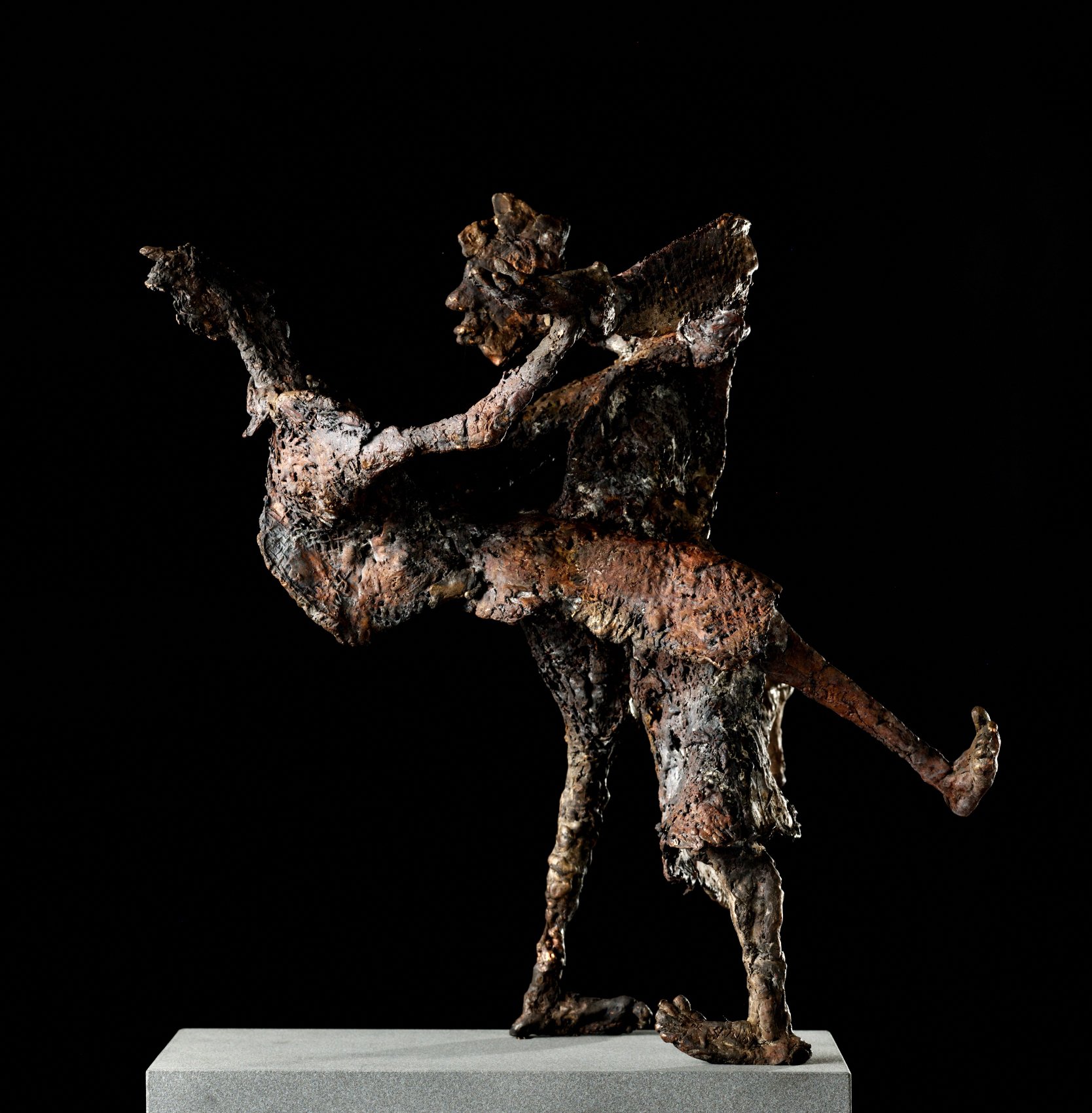
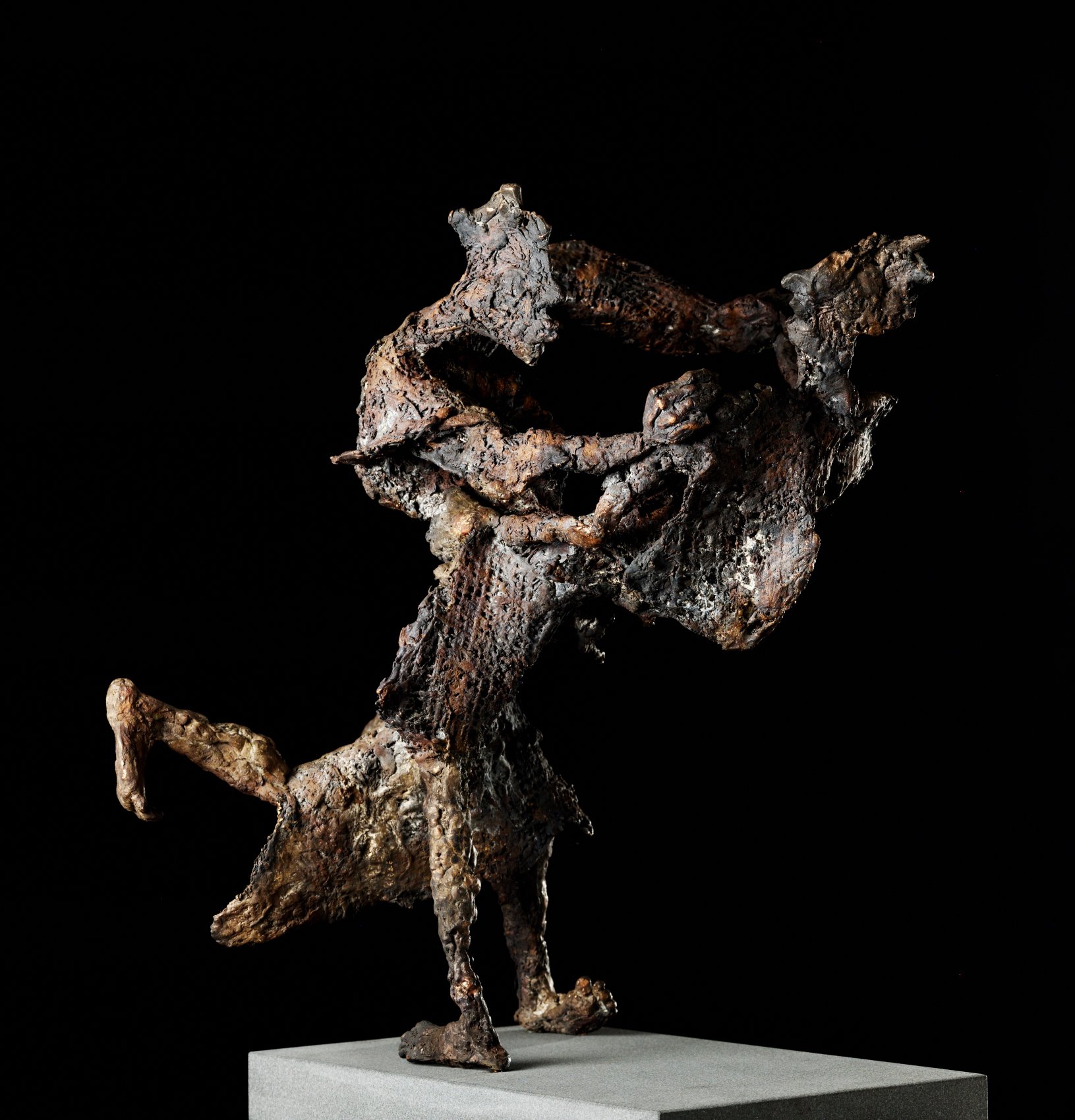
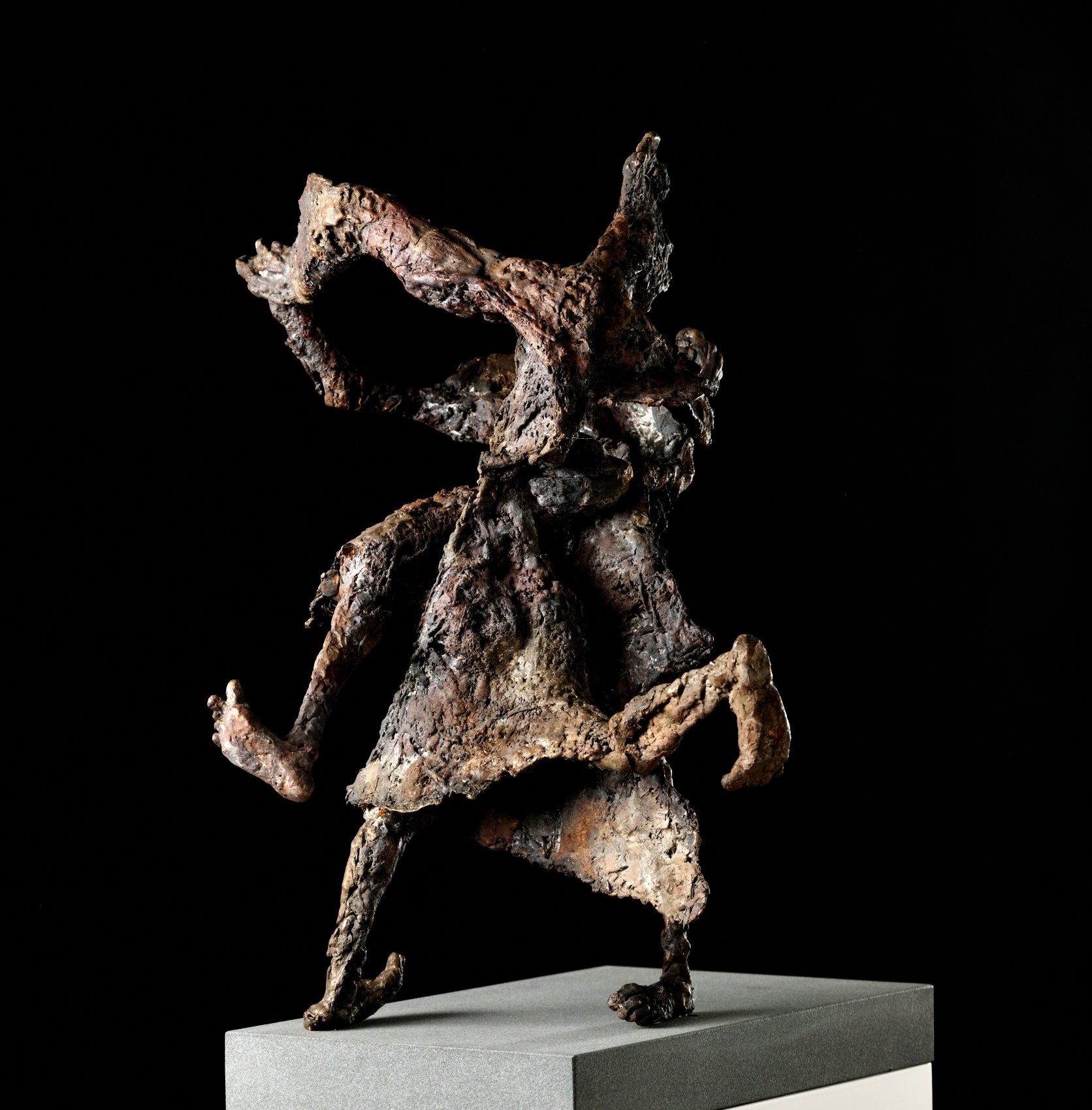
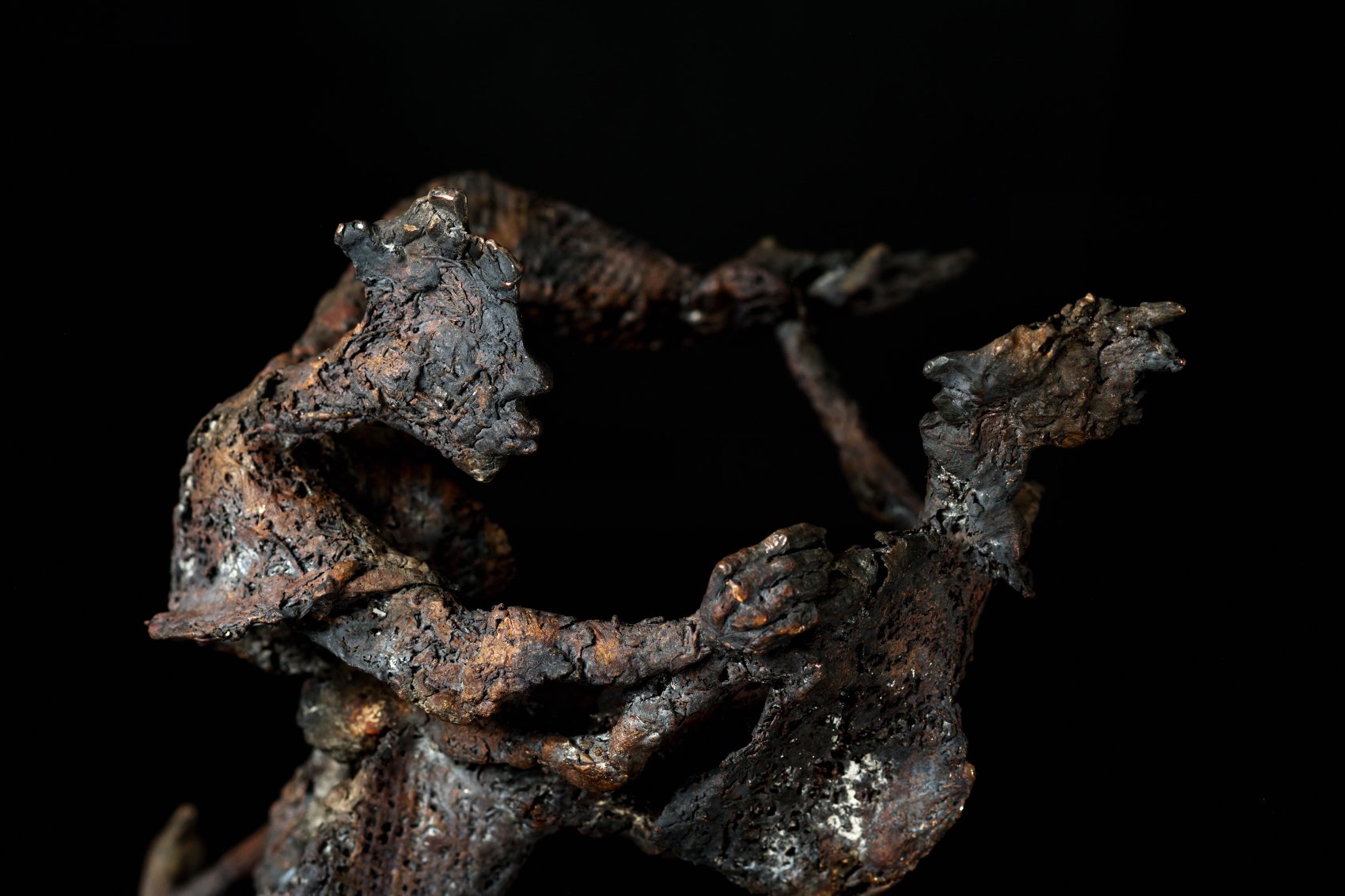
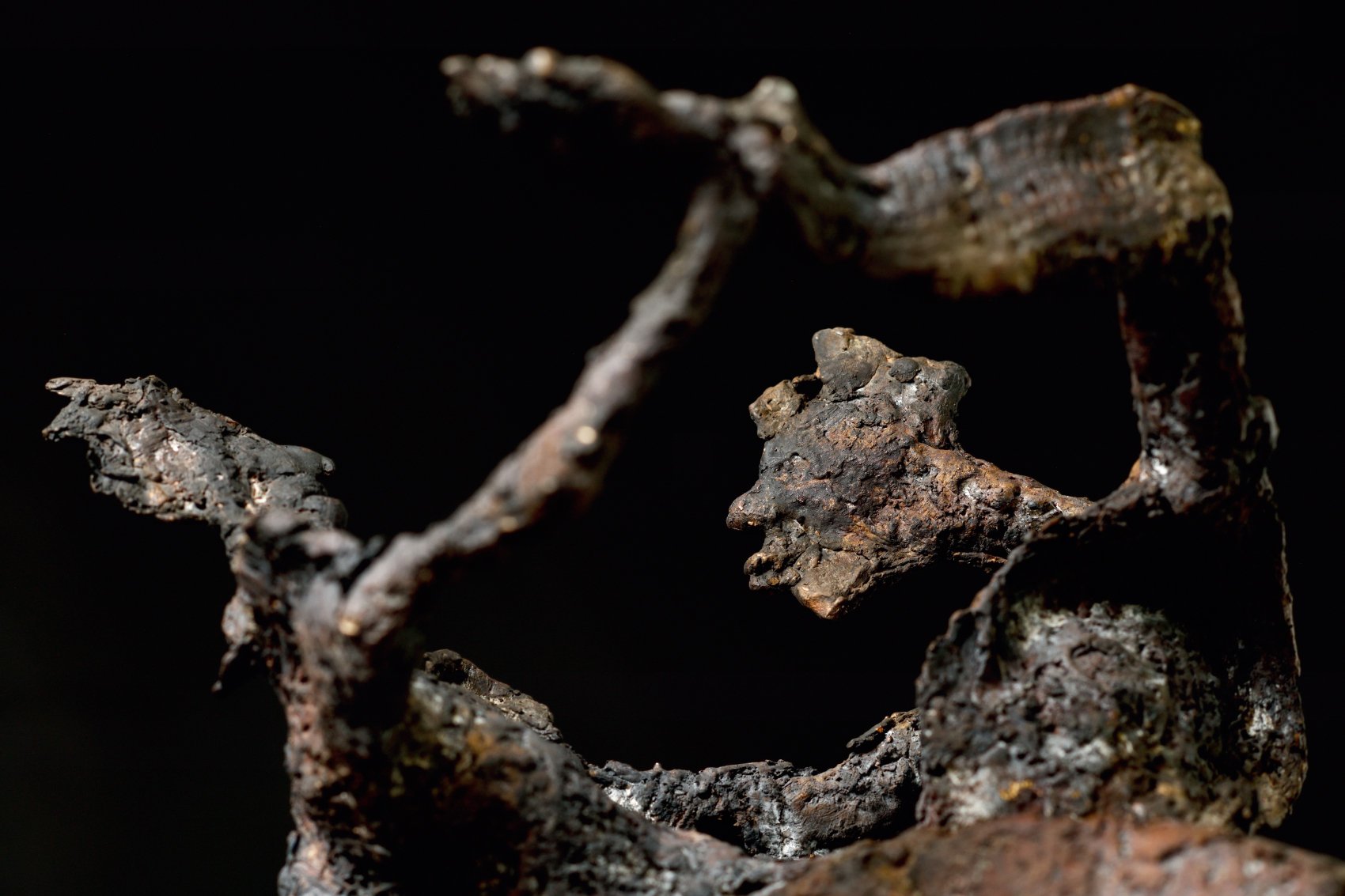
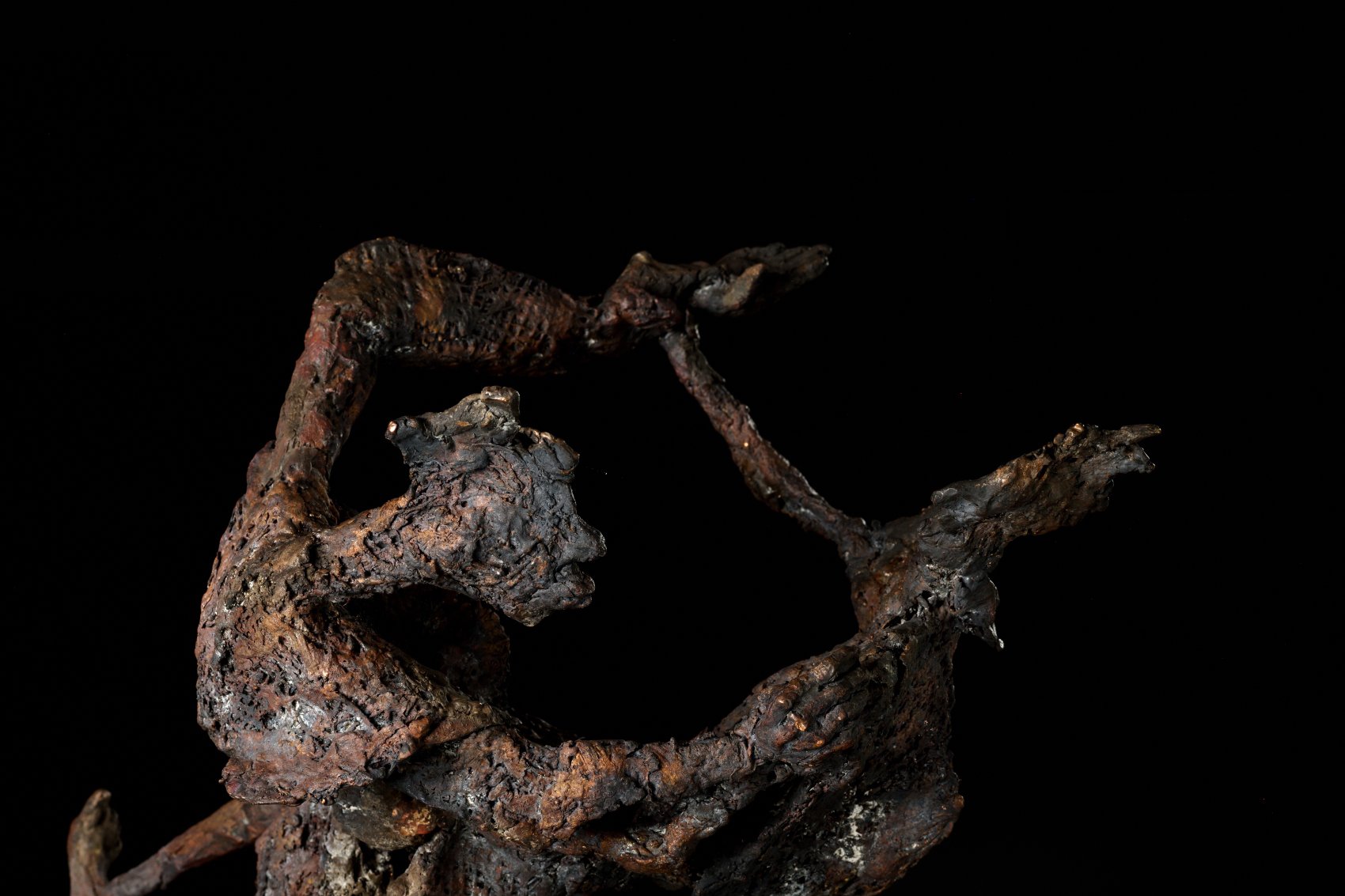
Amour Fou or Living a Luminous Life Bronze, 44 x 43 x 41 cm
U: You certainly embrace Lacan’s thinking when you propose we follow our own interpretation of the world, a kind of infinite order, in which we see ourselves as holistic, at one with the world. Still, some of your works seem to end just in time before the portrayed protagonists leave for their grand journey toward the infinite. How can we emerge out of agony and oblivion? And how are our actions related to the infinite chain of causes that contours our demeanors?
G: These are very important and complex questions. I try to be absolutely genuine – the transformation into infinity is very much dependent on ourselves. There is no psychotherapist or other dominating authority, be it a higher force or the force of reason, that can tell us what exactly to do. Lacan’s view hitherto is: psychoanalysis just does this primary job of showing that and how there is a chasm between joy and anguish, but then, about what precisely to do, he leaves it open; he gives responsibility to us. We need to grapple with the unique dilemma of the human condition. And yes, he still offers some ancillary counseling.
I fear we need to go beyond psychoanalysis. My proposal with regard to the transformation towards infinity is threefold:
First, as mentioned earlier on, we shall overcome the wistful focus on the human psyche and attend to the human soul instead. We, humans, are complex beings and shall not be reduced to creatures with unconscious and conscious layers of existence. The soul represents the ubiquitous essence of each of us as individuals. And it is part of something bigger and more ancient than we are; the soul inherits our past and charts our future, and the soul unfastens the hatches toward infinity.
Second, we need to break the closure of structuralist thinking. Don’t take me wrong; we should, of course, unveil the structures that underlie all the pursuits that humans do, think, perceive, and feel – that messy construct Lacan called ‘language.’ But we are also obliged to overcome the intimations of grammar-frozen truths. I believe that human beings are basically free and have ample choices they can make, enabling them to move from language to latitude. To put it in very simplistic terms – and quoting Lacan, who alluded to the need to destroy his own structuralist thinking: we need to thaw our ice mantle to reach infinity. We should focus on our becoming.
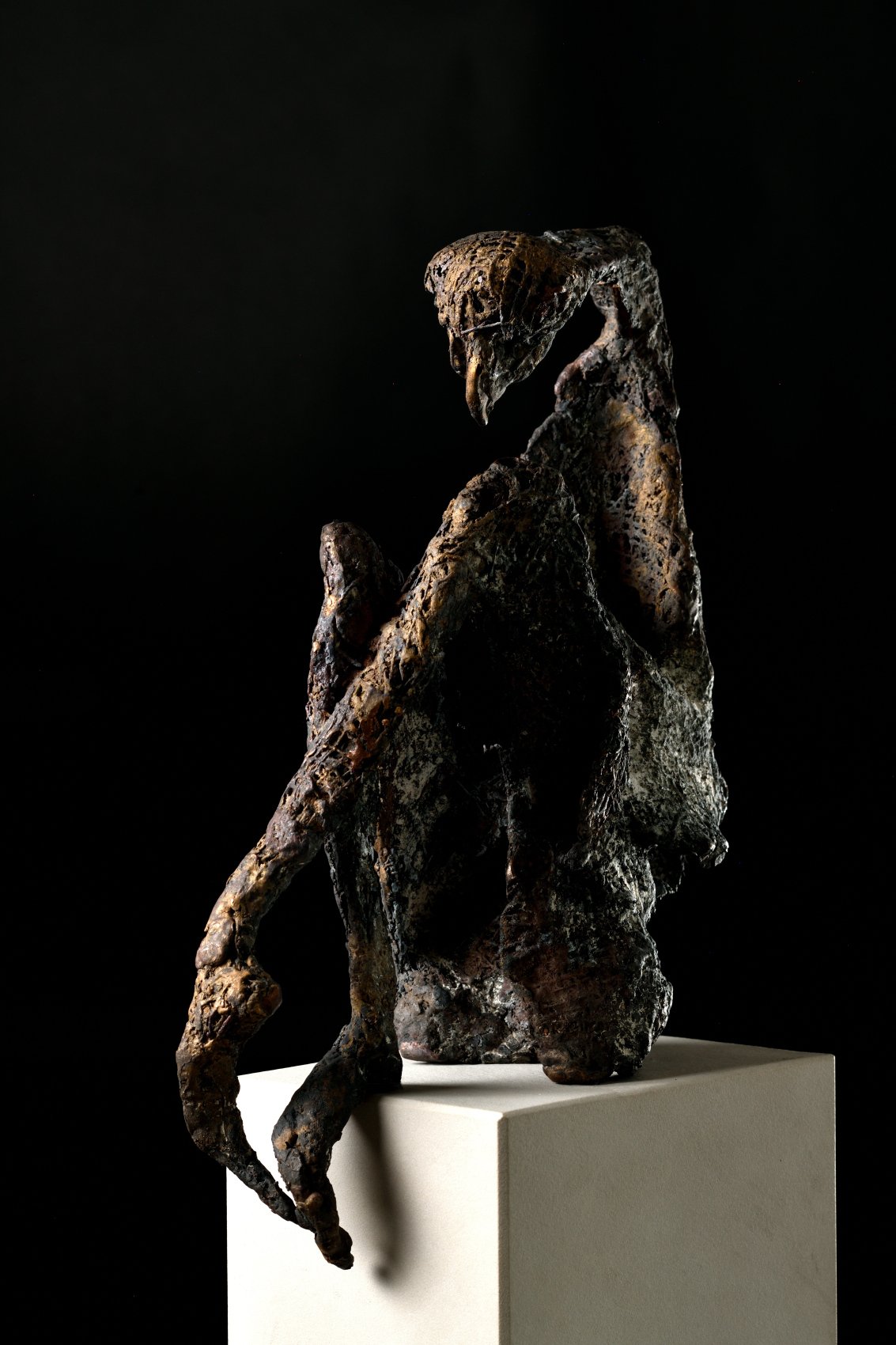
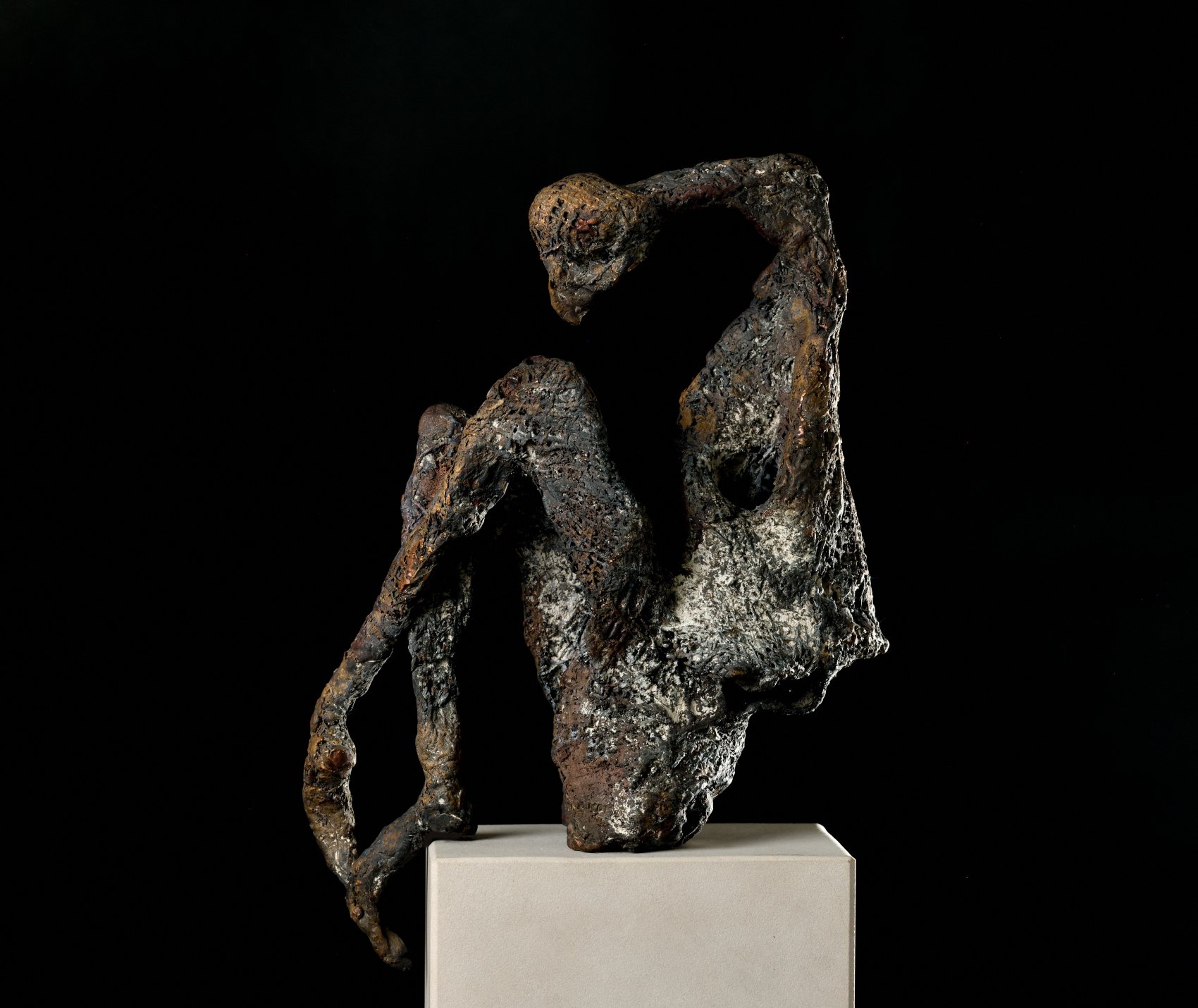
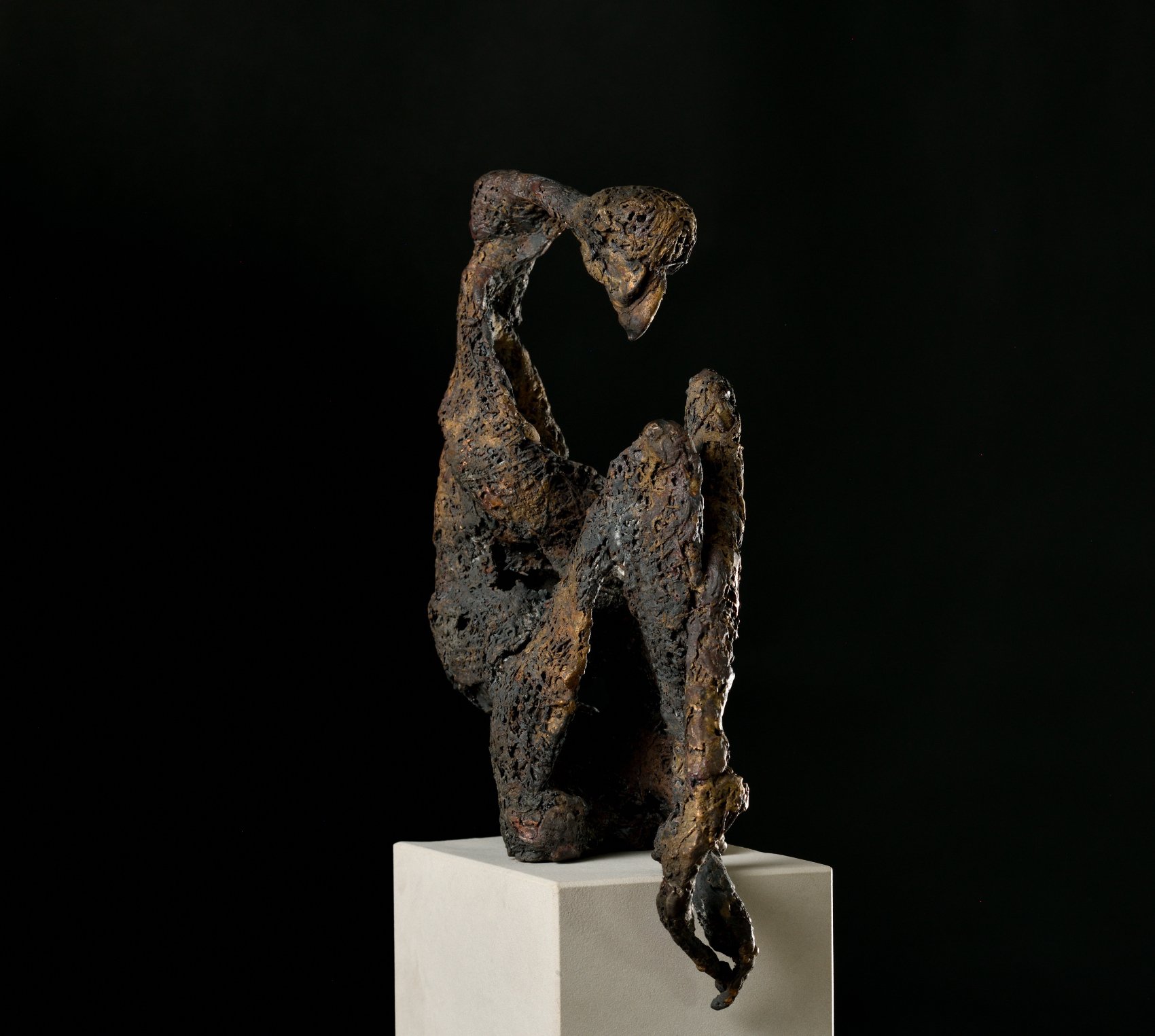
Silent Resignation Bronze, 40 x 12 x 25 cm
Third, we are bound to put our becoming in relationships with others, our fellow travelers through life, respecting the existence of souls outside ourselves, interacting with them, and sending elated messages of affection into the intersubjective space. Let me aspire to place the human being in a face-to-face topography. We need to get beyond ourselves, enabling us to exist in relation with others, together with others.
I know the transition towards the infinite within the proposed framework - adding the dimensions of ubiquity, latitude, and togetherness to mainstream Lacanian thought - is a rather theoretical construct. And it is perhaps better that the users of that framework stay on the theoretical side without too much leaning towards mere practical prescriptions. The coveted transition is not attainable through the pushing of some simple trigger points – the human soul is an ephemeral sensory thing.
Here is my visual comment on this state of cerebration: The sculpture Amour Fou or Living a Luminous Life is about a knotty couple who are enthralled in an increasingly turbulent flirtation with each other. A woman and a man are clinging together; they dance like in a trance but go far beyond mere Freudian libido. There is a true desire, an ebullient desire to reach infinity. The couple’s sensual and ethereal entanglement continues, to this day, to be the center of life. Almost twistingly besotted, they are heading towards a luminous life - by inciting togetherness, seeking a joyous union with the other and the world, they construct on their own, around their souls. As they linger, many new and larger worlds are emerging. The couple jointly synchronizes love. The couple jointly touches the infinite.
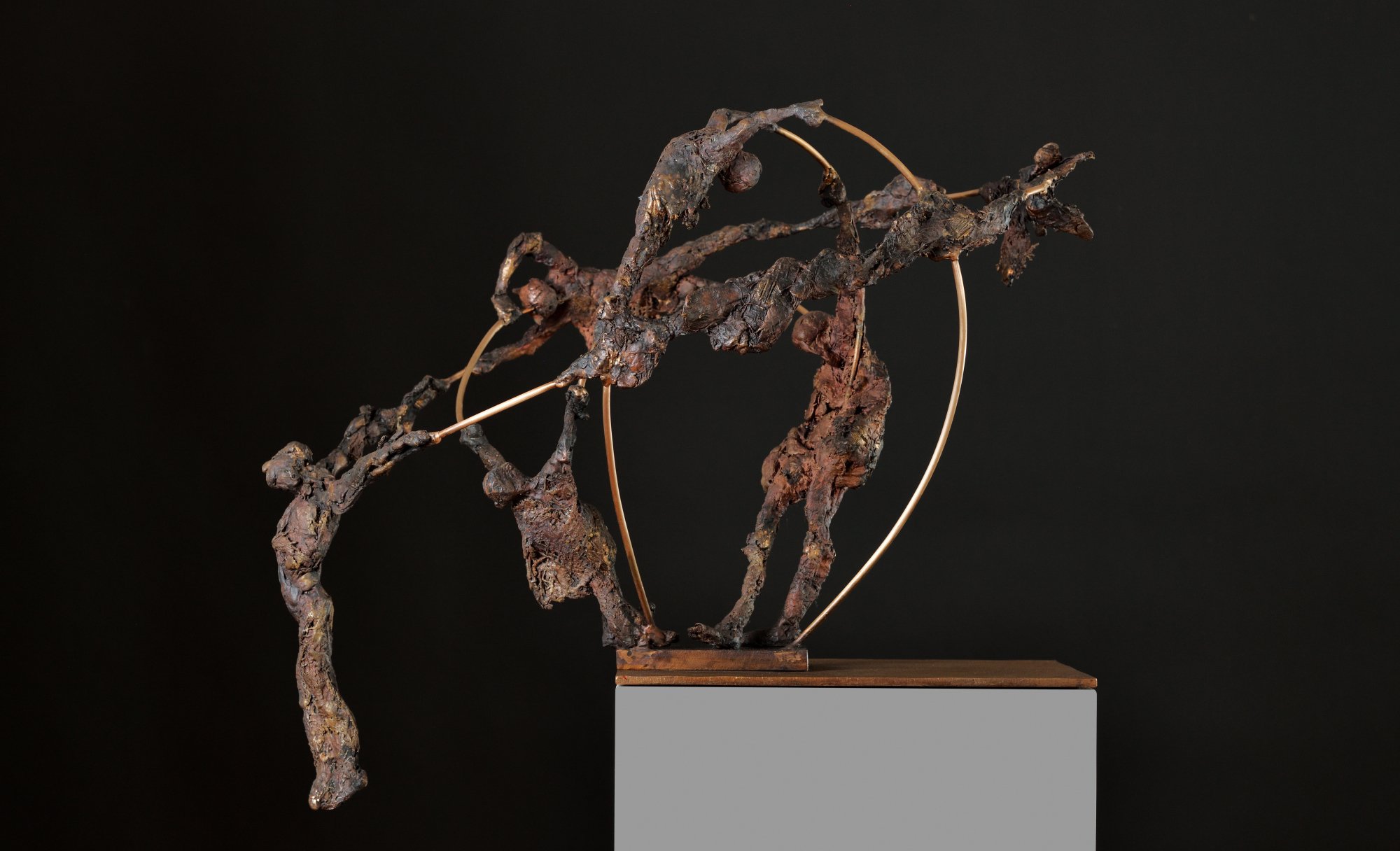
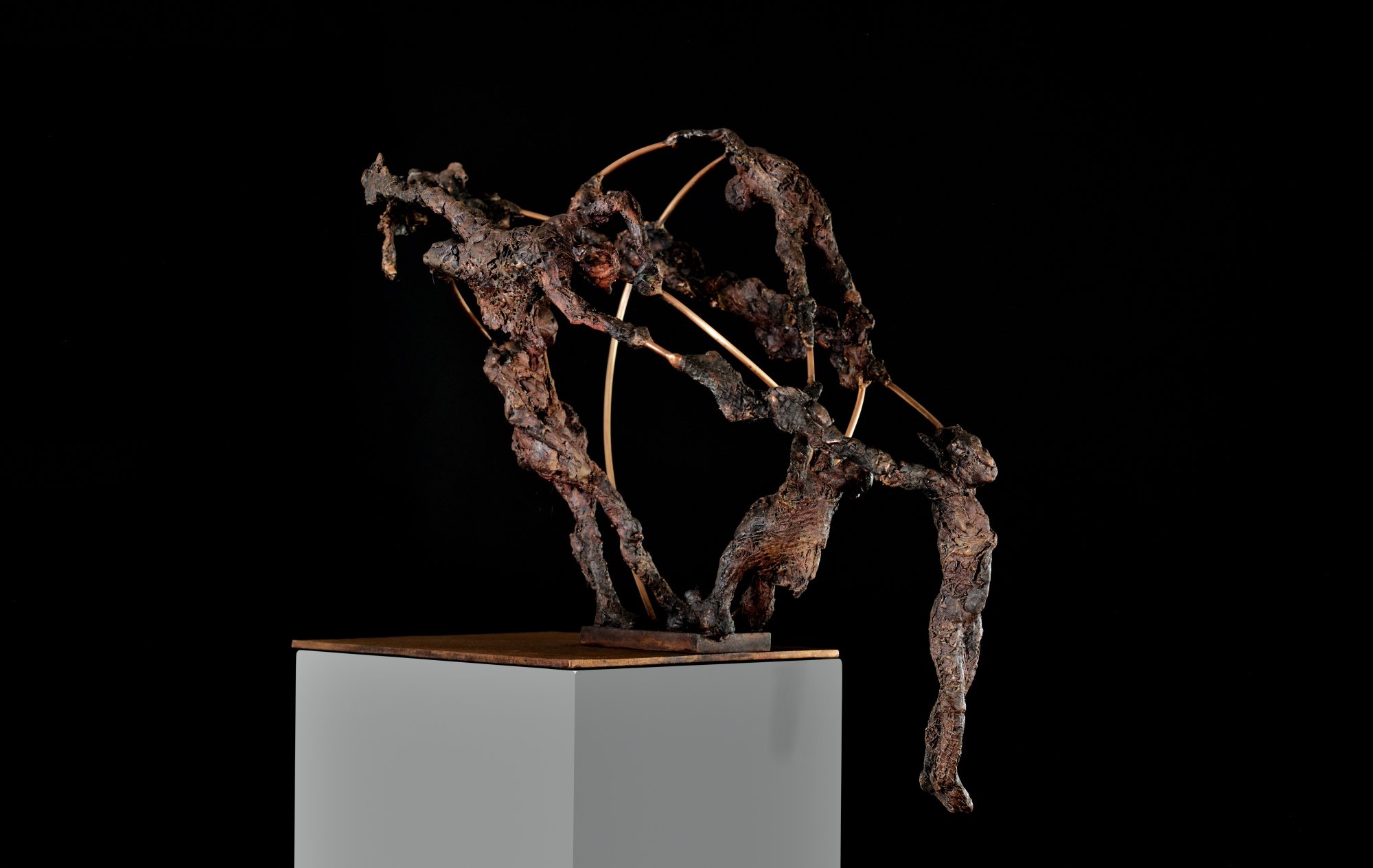
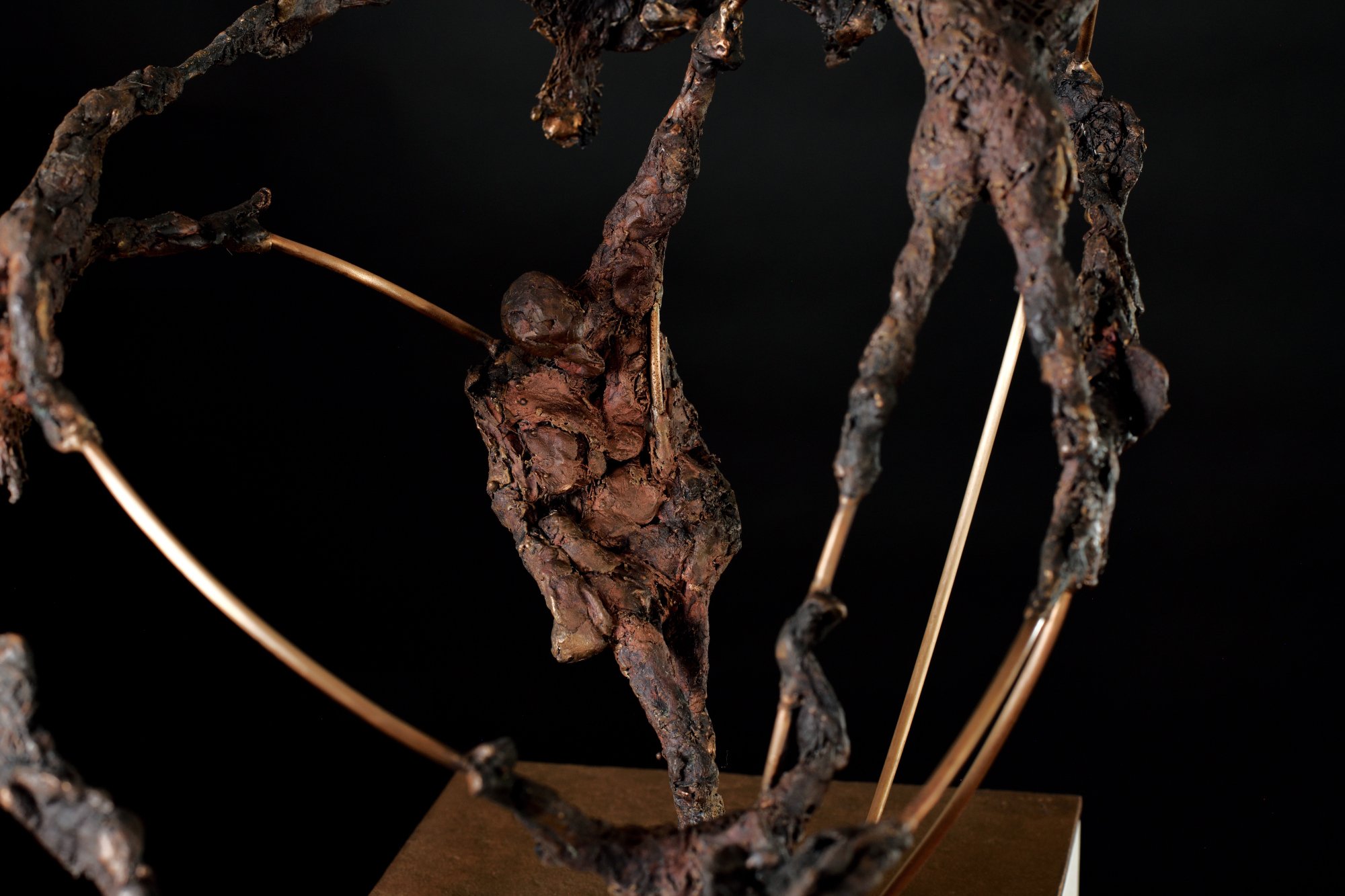
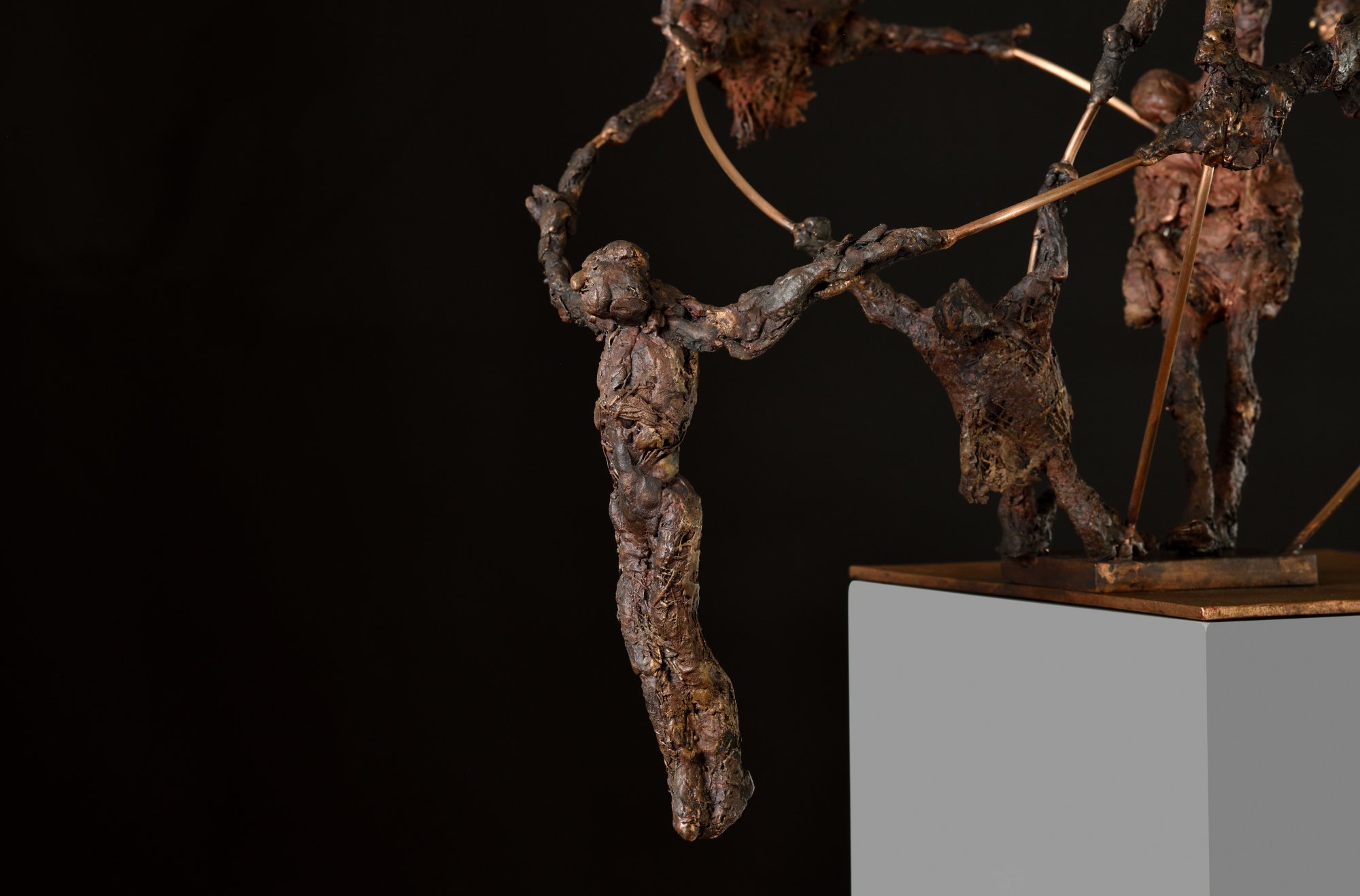
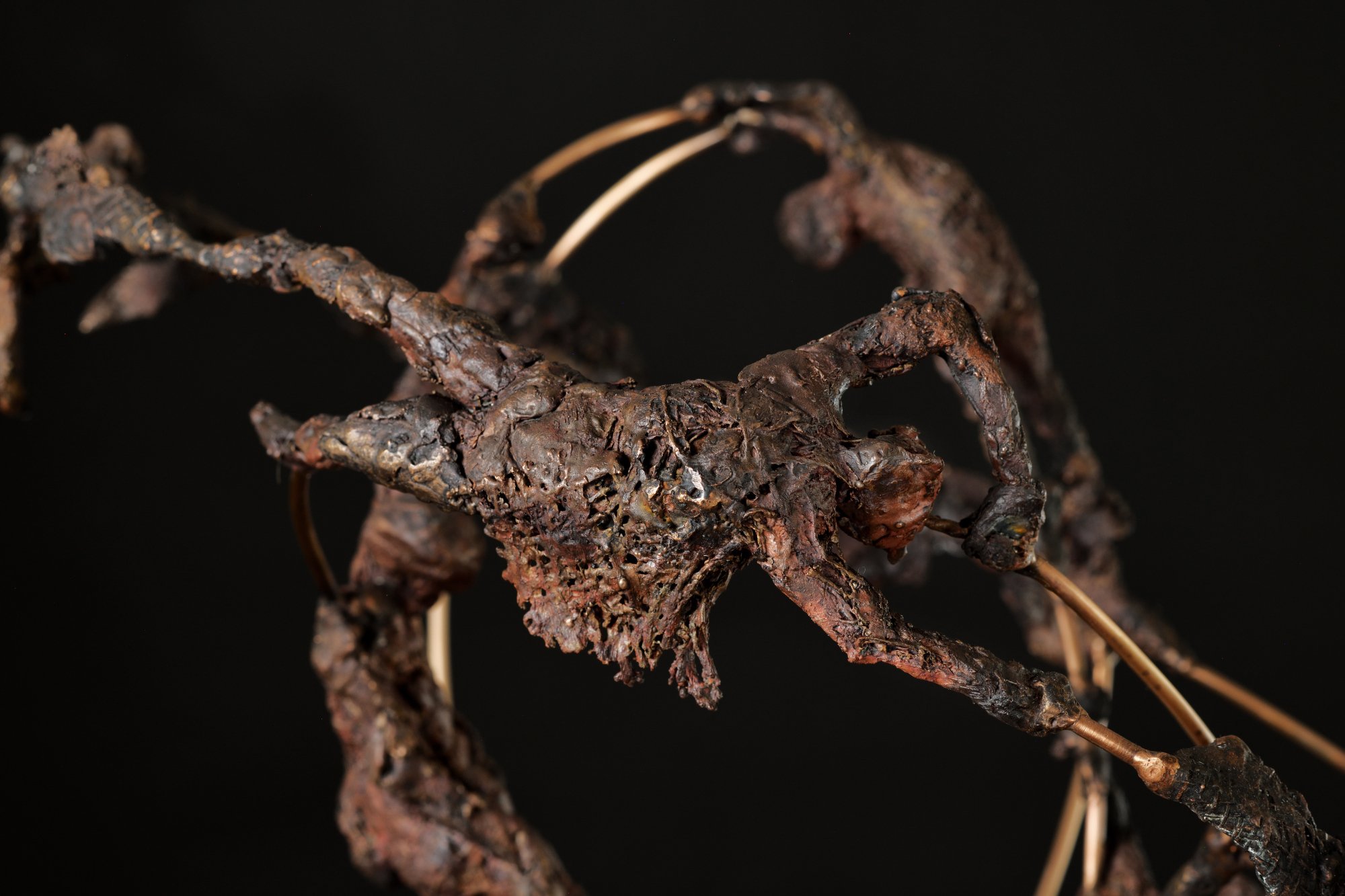
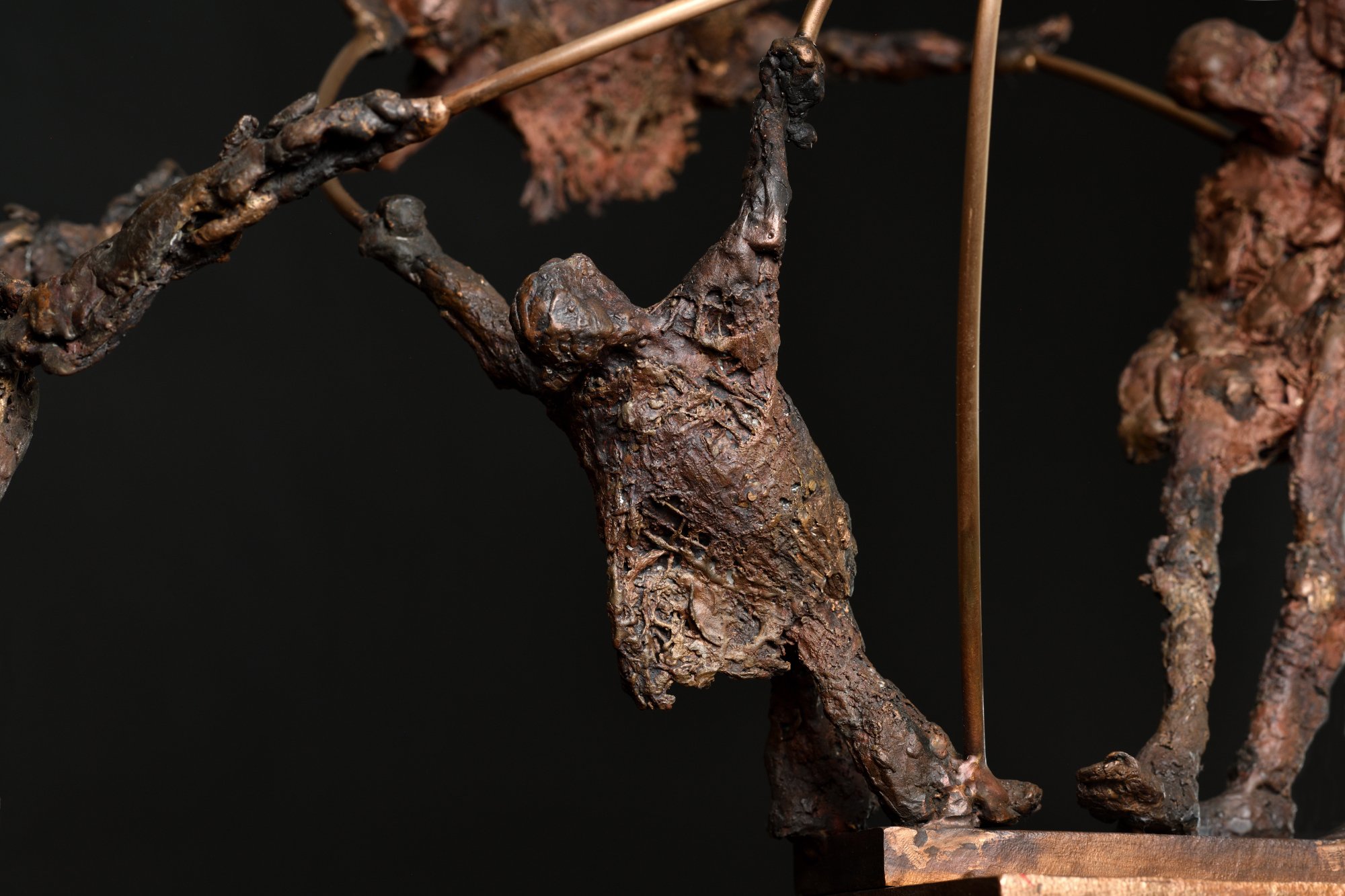
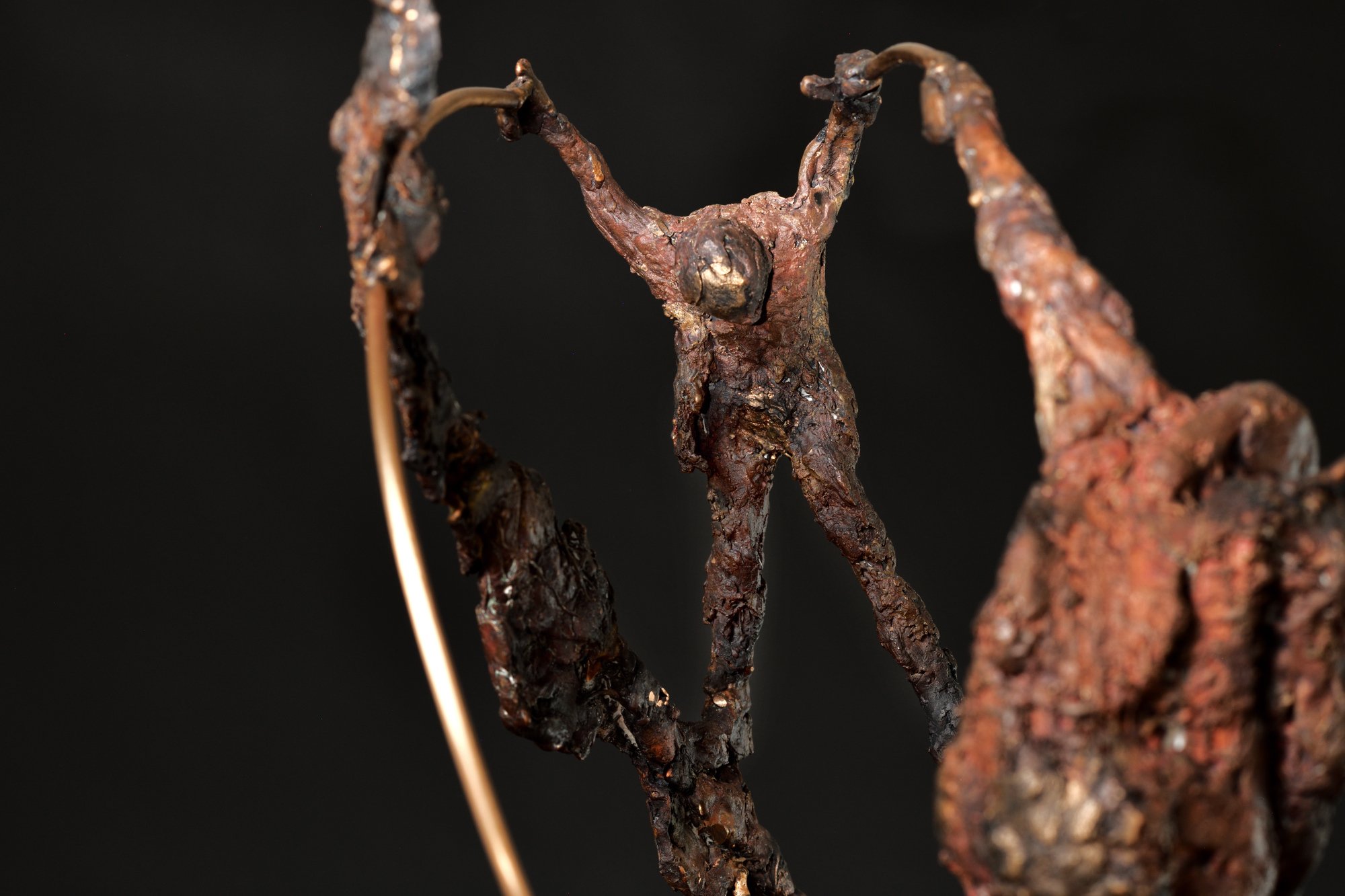
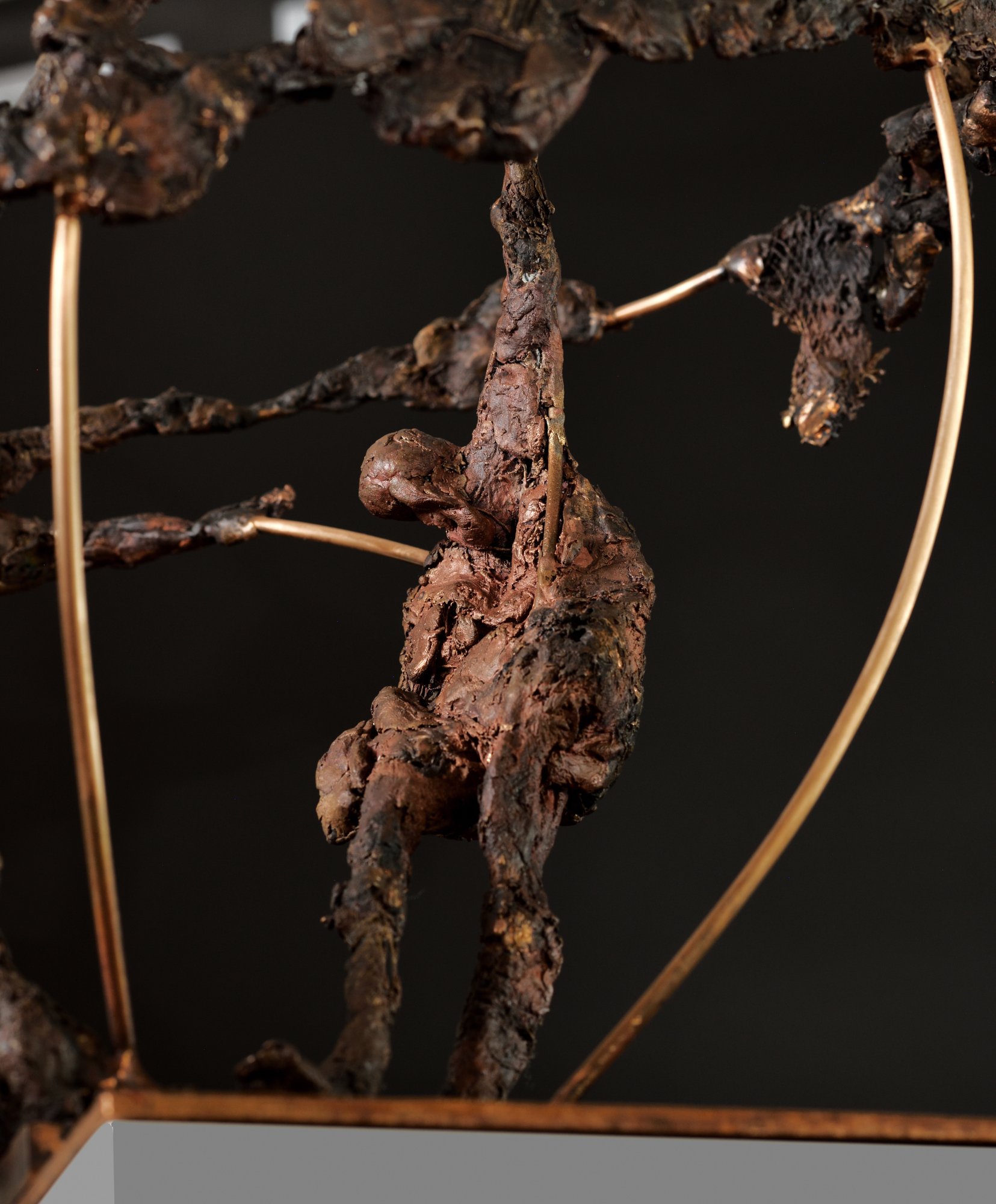
Meandering Souls Bronze, 50 x 40 x 56 cm
U: I really enjoy your interpretation of Lacan. Going off from what you were saying about floating toward many new and larger worlds, what and how would you say infinity constitutes itself?
G: I examine infinity through the medium of sculpture. The characters in my works are searching for a connection with that infinite; they emancipate themselves from neurotic inhibitions in a very Lacanian sense. Aspiring to long to belong. Achieving a mutually humane and compassionate existence and leaving an unwavering fervent trace, as exemplified in Meandering Souls:
A group of people is hanging and spinning together. They are whispering to one another in the hovering space of infinity. Earlier on, and still, at this very moment, they have been involved in tremendous trials and tribulations. Soon, flooded by intuition, they would reach to infinity: it would behoove to rest on a circle of connectedness. Though struggling with anxiety arising from awareness of ubiquity, latitude, and togetherness, they enkindle the hazard of fluid being. They are testifying to a disturbance in the unconscious and overcoming it. They float, intimating inchoate but all-embracing desire.
There is no solid matter, only a forever-transforming passage toward that infinite horizon, not realizing how our souls intimately meander within the fluidity of our being.
The gleam of the infinite is reflecting back at us.
U: Thank you for this intriguing conversation, Dr. Gindi, for sharing with us your forays into the infinity of the human soul. And how you capture, chart, and cast it in your works.
For more information about Dr. Gindi’s artwork, please visit his site. Also, you can follow her on Instagram.
